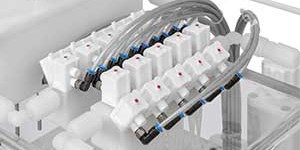In the energy storage market, lithium-ion batteries are considered to be a cost-effective solution.
Owing to its high energy density, lithium-ion technology is seen as a highly efficient electrochemical store and is therefore also used for new applications, such as actuator technology in hybrid and electric vehicles. Customer acceptance is significantly dependent on falling procurement costs and acceptable mileage and range. For this reason, all well-known battery manufacturers have tested the facilities where lithium salts are processed and filled.
Media such as lithium salts, sodium bromide or lithium polymers have chemical and mechanical properties that make industrial treatment significantly more difficult.
Filling the cells with liquid electrolyte is a process step which is critical to successful battery production, as a precise filling level must be reached. A networked system of piping, tubes and optimally draining valves enable the precise filling level to be reached and, at the same time, minimize the maintenance required by the battery filling system. An optimized draining system for electrolyte filling as well as integrated cleaning processes help to prevent the crystallized particles from remaining, thereby protecting the entire system. This extends the service life of the individual components, which leads to a reduction in the cost of the filling process.


